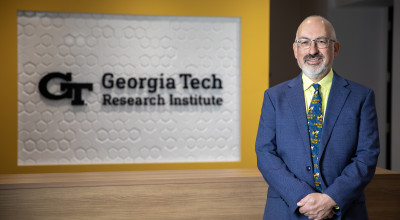The Georgia Tech Research Institute (GTRI) has demonstrated that its nanoparticle technology improves efficiency and reduces waste in municipal wastewater treatment, ensuring safer discharge or reuse, with the potential to reduce operational energy costs.
In recent pilot tests conducted at the City of Woodstock’s wastewater treatment plant in Georgia, GTRI’s solution effectively removed pollutants, including suspended solids, organic waste, nitrogen and phosphorous species, while reducing chemical use and the amount of waste produced. The tests proved that the nanoparticles and key nutrients could be recovered and reused, and that the technology has potential to be implemented on a larger scale.
“We were pleased with the results,” said Jie Xu, a GTRI Regents’ Researcher who is leading the project. “Compared to traditional water treatment processes that require multiple steps, our approach streamlines the process and require less space, which speeds up the process efficiency significantly. Our system also removed contaminants without requiring additional chemicals, which was a huge cost-saving factor.”
One major purpose of wastewater treatment is to remove contaminants from wastewater, making it safe to return to the environment or be reused. The process is crucial for protecting both public health and the environment by reducing the concentration of harmful pathogens such as bacteria and viruses along with removing toxic chemicals and heavy metals that can contaminate drinking water sources and pose health risks. Wastewater treatment also prevents excess nutrients, like nitrogen and phosphorus, from entering the environment, maintaining the health of water resources.
Current wastewater treatment uses chemicals for phosphorus reduction and to promote the clumping of fine particles, making it easier to remove contaminants from the wastewater. However, this process generates a byproduct called ‘sludge,’ which consists of organic matter, solids and microorganisms that remain after the water has been treated.
The main concern with sludge is its potential to contain harmful pollutants that pose risks to the environment and human health if not properly disposed of or handled.
“One of the biggest issues in wastewater treatment is dealing with sludge,” said Xu. “Right now, sludge can be processed into biosolids for land applications for beneficial use including nutrient recycling and soil conditioning, but that process has come under scrutiny due to concerns about contaminants like PFAS, known as ‘forever chemicals’, and pathogens.”
GTRI’s nanoparticle technology uses tiny particles with magnetic properties that bind to and remove contaminants from water quickly and efficiently. This process reduces reliance on potentially harmful chemicals, lowers sludge production, and improves overall treatment effectiveness. In many cases, nanoparticles can be recovered and reused, further reducing costs.
Michael Rhoads, the plant manager at the Woodstock facility, expressed confidence that GTRI’s nanoparticle technology could reduce excess chemical use, reducing costs for businesses and ultimately benefiting consumers.
“Our partnership with GTRI is huge for our industry and bridges the gap between the lab and actual everyday operations in leaps and bounds,” Rhoads said.
The average cost of wastewater treatment in the U.S. can range from $2 to $5 per 1,000 gallons, depending on factors such as facility size, treatment methods, and local regulations, according to recent estimates. That would amount to costs as high as $5 million per year for an average-sized plant, and potentially much higher for larger facilities.
Xu said her team treated about one gallon of water per minute – and over 300 gallons per day – at the Woodstock facility. However, she noted that typical municipal wastewater treatment plants process millions of gallons per day.
Looking ahead, GTRI aims to scale up its water treatment to meet these requirements and expand its testing to industrial wastewater treatment facilities such as poultry processing plants and paper mills.
“Municipal wastewater treatment is one application, but industrial wastewater treatment presents different challenges, so we want to validate our system in those settings as well,” Xu said.
GTRI also partnered in this project with water treatment companies Xylem and EOM. The companies provided critical equipment for the pilot, specifically a dissolved air flotation unit that is widely used in wastewater treatment to separate pollutants from the water.
This pilot effort was supported by funding from the National Science Foundation (NSF) and the Georgia Research Alliance (GRA), building upon original research funded by GTRI’s Agricultural Technology Research Program (ATRP).
ATRP drives transformational innovation, developing new methods and systems specifically designed for poultry, agribusiness, and food manufacturing applications. These innovations are created to maximize productively and efficiency, advance safety and health, and minimize environmental impacts. ATRP’s goal is to transition technologies from concept to commercialization as quickly and economically as possible.
Writer: Anna Akins
Photos: Sean McNeil
GTRI Communications
Georgia Tech Research Institute
Atlanta, Georgia
The Georgia Tech Research Institute (GTRI) is the nonprofit, applied research division of the Georgia Institute of Technology (Georgia Tech). Founded in 1934 as the Engineering Experiment Station, GTRI has grown to more than 3,000 employees, supporting eight laboratories in over 20 locations around the country and performing more than $919 million of problem-solving research annually for government and industry. GTRI's renowned researchers combine science, engineering, economics, policy, and technical expertise to solve complex problems for the U.S. federal government, state, and industry.




